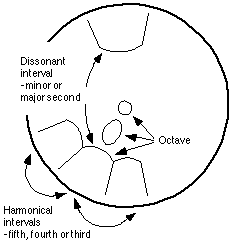Met a steel drum player at a party this weekend and had an enlightening shop conversation involving the tuning and layout of notes on the instrument. Found some great information from A Handbook For Steel Pan Making And Tuning:
The layout of the notes in the pan is, of course, important for the ergonomy of the player. But there are also important acoustical considerations in the positioning of the notes in a good pan. As the whole pan vibrates every time a note is struck, it is important that the notes that are vibrating the most sounds well together.
To understand the theoretical foundations for a good note layout it is useful to know the musical relations of the partials of a harmonic tone, see the chapter about partials above. The intervals that have the most harmonic relationship are the octave, the fifth, the fourth and the third. If notes at these intervals ring together with the struck note, they will support its harmonic spectrum. Therefore, a favourable design is to put these notes close to each other.
The general idea for a good note layout in steel pans is to position notes with a harmonic relationship as close to each other as possible, while placing notes with a non-harmonic relationship as far apart as possible. A design notion that is valid for all steel pans is that the octave counterparts always are placed close together. Fifths, fourths or thirds are also consequently placed close to each other in some pans, as in the fourths-and-fifths tenor and the quadrophonic pan with their ingenious designs.
Notes with a non-harmonic relationship – as the minor or the major second – are usually placed as far apart as possible, preferably in separate drums. If the notes with semitone intervals are spread consistently over different drums, pans with different numbers of drums will have correlated minimum intervals that have to be placed in the same drum: Two drums – a major second, three drums – a minor third, four drums – a major third.
Principle for a harmonical distribution of notes.If notes with a dissonant harmonic interval – one or two semitones apart – have to be placed in the same drum, they are usually placed on opposite sides of the drum. On the other hand, if the smallest interval between the notes that have to be placed in the same drum is harmonic, the notes are put close to each other to support each other’s harmonic spectra.
The acoustical implications of a good layout are that it will make the pan sound better and make it easier to tune. A pan with more octave notes will be harder to tune due to the interaction of the notes. But it will also be easier to get a good tone in the end, because the notes in the upper octave will support the lower ones with higher partials. This is very easy to demonstrate; just put a finger on a high note while playing on its lower octave counterpart – this will usually make the brilliance of the lower tone disappear.
“Roads” between notes
The acoustic function of the “roads” – the space between the notes – is to damp the acoustic waves coming from the vibrating note before they reach the surrounding notes. This means that an increased distance (or a double groove) reduces the interaction between two adjacent notes.
The more dissonant the relation between two notes, the more they need to be separated. On the contrary, the better the acoustic separation between the notes, the less the need will be to keep the dissonant tones apart.
Sometimes, ergonomic or construction considerations are judged to be more important than the acoustical ones. The double tenor is an example of this. A double groove has been introduced to make it possible to put dissonant notes close together and still have a well-sounding instrument with many notes in it.
Pans that are designed with harmonically sounding notes close to each other, as the fifths-and-fourths tenor, may have adjacent notes put close together, with just a single groove between them. Octave counterparts should always be put as close together as possible, to enable positive feedback.












